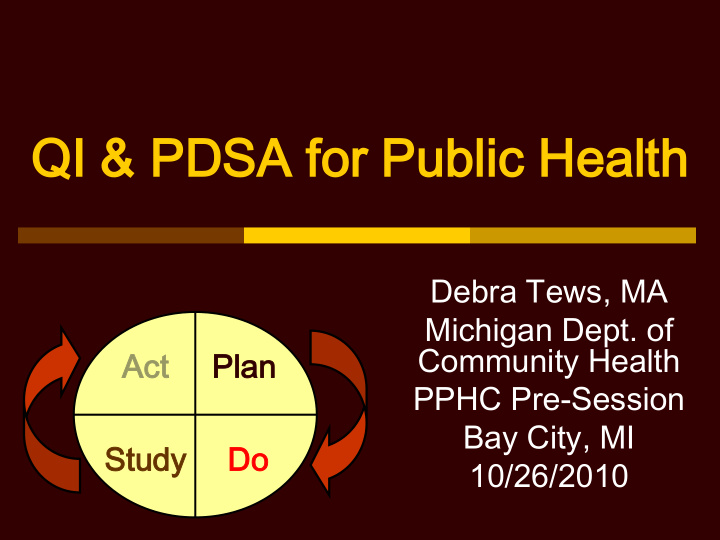



QI QI & & PDSA f PDSA for or Publ Public c Heal Health h Debra Tews, MA Michigan Dept. of Community Health Ac Act Pla Plan PPHC Pre-Session Bay City, MI Study udy Do 10/26/2010
To Today’s Fo Focus A brief overview of QI including PH definitions for Quality and QI An intro to PDSA from Michigan’s Quality Improvement Guidebook An intro to QI tools
Wha What i is Qua uality in Public He Heal alth? “ Quality in public health is the degree to which policies, programs, services and research for the population increase desired health outcomes and conditions in which the population can be healthy.” Public Health Quality Forum
So Ho o How Ca w Can n One De e Define Qua uality Imp mprovemen ment for or P Publ blic He Heal alth? Use of se of a a del delibe bera rate e and and def define ned i improv provement proc process, such such as as Plan an-Do Do-Check eck [ [St Study] dy]-Act Act, which is focused on activities that are responsive to community needs and improving population health. It refers to a continuous and ongoing effort to achieve measurable improvements in the efficiency, effectiveness, performance, accountability, outcomes, and other indicators of quality in services or processes which achieve equity and improve the health of the community. Accreditation Coalition 2009
Why Why QI i in P n Pub ublic He Health? h? Tough ough Econom conomic QI Ca QI Can: Times es Requi equire re a a Reduce costs and Differen ent A Approac pproach! redundancy Eliminate waste Streamline processes Enhance ability to meet service demand Increase customer satisfaction Improve outcomes
Is it QI or is it QA? Quality Improvement GOES BEYOND Quality Assurance!
Doing Both? QUALITYASSURANCE relates to Monitoring & Compliance. It GUARANTEES quality. Standards met? Deficiencies corrected? QA is . . . . . reactive! QUALITY IMPROVEMENT relates to Learning & Improving. It RAISES quality. Quality can’t always be assured. Ongoing efforts to identify opportunities for improvement are needed. QI relies on measurement & data-driven decisions to improve outcomes. QI is . . . . . proactive!
Princ ncipl ples es o of QI From the Public Health Memory Jogger Pocket Guide of QI Tools: Develop a strong customer focus Continually improve all processes Involve employees Mobilize both data and team knowledge to improve decision making
Th Thre ree K Key Questions ! !!! 1. What are we trying to accomplish? 2. How will we know that a change is an improvement? 3. What changes can we make that will result in improvement?
Change nge Vs. I Improv ovem ement ent Edwards Deming: Of all changes observed, about 5% were improvements, the rest at best were illusions of progress! To move beyond illusions of progress, a QI method (PDSA) and QI tools are needed. Embracing Quality in Local Public Heath: Michigan’s QI Guidebook explains the PDSA method and suggests tools.
Sna naps pshot: P Plan an-Do Do-Study-Ac Act (PD (PDSA) SA) Ac Act Pla Plan Study udy Do
Some C Common To Tools o of QI Understand Your Process & Process Mapping Make Sense of Your Data! Cause and Effect/ Fishbone Diagrams Five Whys Run Charts Pareto Charts Check Sheets
QI: A Assembling the he P Pieces Listen to LHD customers Use data to make data- driven decisions Continually improve processes in your LHD Use recognized QI methods and tools Work together; a team approach is best. Ask the 3 Key Questions!
What D Do Users Say? “We now have staff eager to use the same tools/methods to evaluate performance and make improvements in other areas of our work” MLC-3 LHD “The PH focus of the Guidebook helps with the application of QI methods; it becomes ‘real’ for participants . . . we can ‘look through our public health windows’” “I refe “I re fer to to th the Allegan LHD Gui uide debo book ok of often n “For any PH agency interested in learning even ev en though hough I I QI and how PH can apply these know now t the s he steps eps” principles/methods, I would recommend MI Mento MI Me tor they start with this Guidebook” Saginaw LHD “The Guidebook has been a road map for our team as we navigate our way down this new path of improving our processes” MMDHD
Th There’s More re . . . . . “The Guidebook has been incredibly useful for QI work, serving as the primary textbook for teaching QI throughout the department” MI Mentor “The Guidebook helps with “The he Guidebook debook is capacity building . . . it would the he gl glue ue that hat hol holds not be possible to spread QI the he whol hole ef effor ort methodologies easily without it” toget ethe her” Muskegon LHD MI Consul ultan ant “The Guidebook is used in our QI meetings as an effective discussion and clarification tool; it generates comfort levels” Allegan LHD
QI Res Resources f es for Pub ublic He Health www.accreditation.localhealth.net and www.phf.org
Another Resource for r QI To Tools http: / / www.langfordlearning.com
Recommend
More recommend